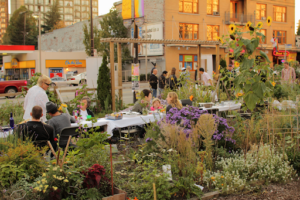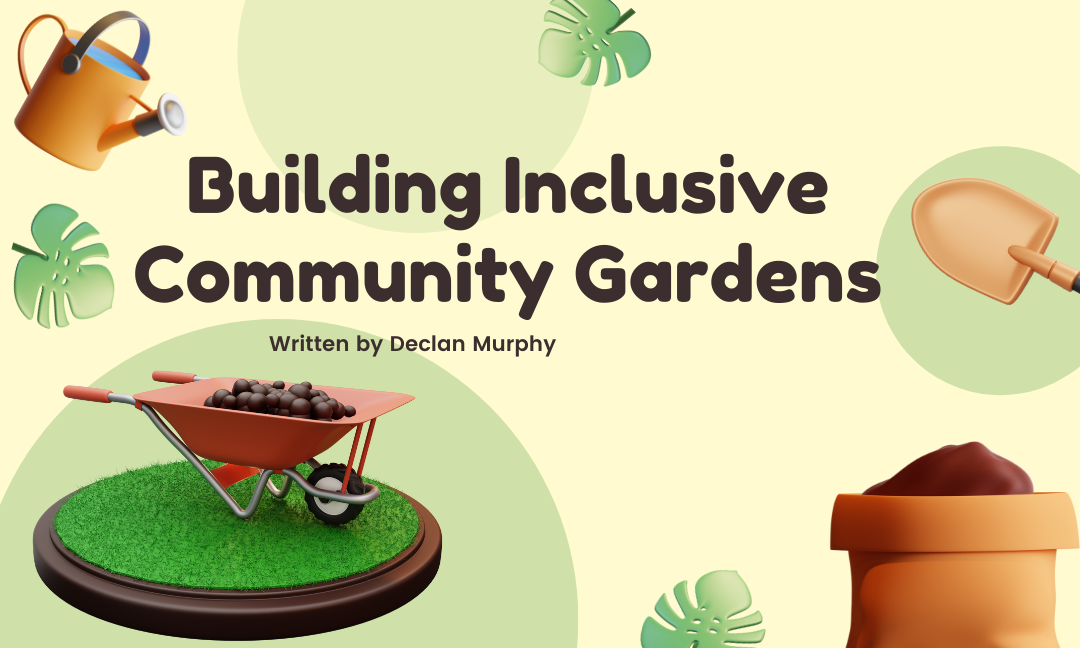Written by Declan Murphy
Edited by Kiritika Rana
Designed by Kiritika Rana
Published by Kiritika Rana
Gardening, and the healthy foods it can bring, is something that can benefit everyone – as long as we are careful to make sure our community gardens remain inclusive, welcoming places for all.

Community gardens are communal spaces for public growing use. There are community gardens in rural areas, as well as urban, and they flourish in places around the world. In some community gardens, people are assigned individual plots, and in others, the community works together on communal crops. Some community gardens grow flowers, but most grow food; many grow both! Wherever they are, community gardens are public green spaces that, ideally, should benefit all participants and be open to everyone.
Community gardens can help combat climate change, as well as beautify neighbourhoods and help pollinator populations. As well-managed open spaces, community gardens can also reduce crime, pollution, and other city problems. They can also give kids, families and older people a source of volunteer work, exercise, and socialization. Community gardens can play an essential role in educating the next generation about sustainable agriculture. Most importantly, community gardens can help combat food insecurity by providing low-cost nutritious foods to lower-income people who need them.
To make sure these spaces are effective and their benefits reach all facets of the community, inclusivity needs to be a priority for any person or group wishing to start one. In this post, we will explore some of the accessibility and inclusion issues facing community gardens today. We will briefly touch on financial limitations, age and ability issues, knowledge and language barriers, and the need for cultural sensitivity, as well as a specific need for Canadian community gardens to make special efforts to connect with Indigenous Canadians.
The first disadvantage that must be addressed is probably the most obvious – community gardens must do what they can to reduce financial barriers to participation for lower-income individuals and families. One way we can do this is to provide the means for people to work the garden without spending a lot on their tools and equipment, and by providing seeds, if possible. This might require community partners and sponsors who can contribute materials or money to the running of the garden, and may also require fundraising.
Community garden locations should also be as accessible by public transit as possible, to prevent making private transportation ownership a hidden cost of participation.

Community gardens should also be child-friendly and mindful of the needs of the elderly, as these demographics are important to the goals of community gardening, and are two groups most vulnerable to food insecurity. Community gardens should advertise in diverse ways and not rely solely on social media (which isn’t always accessible to the very old or the very young).
Community gardens must remain accessible to people of differing levels of physical ability. Having accessible tools, for example, as well as a wide variety of useful tasks for differing abilities and easy access to a water source can help lighten the burden of pain that gardening can cause for some people. Making sure that your participants have access to safe, clean washroom facilities and drinking water within easy distance, as well as seating areas with shade, will also create a more accessible environment by making people with physical limitations feel more comfortable.
Wheelchair and other mobility device accessibility can be a challenge for community gardens, but is an important part of ensuring accessibility. Limiting stairs and slopes on your grounds, as well as maintaining accessible paths and entrances are essential. Raised or table beds, as seen in the image below, can make a major difference in the inclusion of people in wheelchairs, as well as for the elderly and people with back and knee pain.

Physical barriers are not the only ones to consider, however. Community gardens should remain aware of differing levels of knowledge, education and language accessibility in their communities. There is more than enough work to be done, and, with effort and determination, important roles can be found for each willing to share the load. Making information accessible to those members who have never gardened before can make new participants feel supported. Offering education in multiple forms, including both physical demonstrations and written formats, can increase agricultural knowledge in your community, and can allow people with different learning styles to pick up the hobby.
Care should be taken to offer educational materials and paperwork in as many languages as possible, being sure to include the languages spoken in your region. If need be, reach out to the various communities in your town and city, and ask for volunteers to help translate your materials.
Community gardens can be real boons for New Canadians, who can benefit tremendously from the social and nutritional benefits of communal gardening. Further, the benefits can easily go both ways! Migrants from more rural areas can be a real asset to urban community gardens, and they can share any agricultural knowledge they have with their new city neighbours. As long as your garden stays welcoming and the leadership is shared and remains transparent, it can benefit from a wide range of skills and knowledge found within its membership!
If community gardens foster inclusivity and welcome all members of the community, they will grow strong and diverse. This growth should lead to an increase in cultural sensitivity within your team and your membership at large. This will certainly include making extra effort to grow culturally appropriate foods for the major groups represented in your membership, and can also extend to fostering multicultural celebrations of the food traditions represented by your membership. This can raise the reputation and profile of your garden within your region, as well as provide fun and tasty foods for everyone to try!
In Canada, there is a particular obligation for community gardens to welcome Indigenous Canadians, in acknowledgement of their role as the first caretakers of the land we use. Urban Indigenous communities often maintain ties to their communities in more rural areas but could use access to garden space closer to where they live. Community gardens can play an integral role in promoting native agricultural practices for these communities and their children. For Indigenous people, making a connection with the land may be very important, and community gardens can help Indigenous families living in cities do this with fewer barriers. Naturally, urban Indigenous people would also benefit from access to affordable, nutritious fresh foods, as well.
Many traditional, culturally important native plants can be included in your community garden, as well. For example, some medicine plants like juniper are not usually recognized as a consumable plants by non-Indigenous people, so many juniper bushes around the city can’t be harvested for tea or berries due to pesticides and pollution. Planting some of them in your community garden and keeping them food-grade could increase the availability of consumable junipers in the city for Indigenous people living in the community.
Of course, the people themselves should tell you what they need, and you should seek to learn from Indigenous communities themselves how to make community gardens in your area more inclusive. Many Indigenous communities have been building communal gardens for a long time. Making connections with these communities and their leadership can be a valuable asset to any community garden in Canada.

To foster inclusivity, community gardens need to be flexible and responsive to the needs of the communities they serve. Most of all, they need to communicate and hear what people are telling them. Encourage feedback and reach out to current and potential participants for opinions on the direction of the garden.
The key to inclusivity in participation, whether you are talking about people with disabilities or people of diverse cultural backgrounds, is inclusivity in planning and management. As disability activists say, “Nothing about us without us!” If you want your garden to include a wide range of people, then you need to include a wide range of people in the planning and building process, as well as throughout the life of your community garden and its maintenance. Making this policy in your community garden will not only increase accessibility, it also foster agency, which is a key foundation for food justice and inclusivity.
Never stop listening and learning, and never stop trying to do better – and always strive to meet the needs of your community, and seek out more people who need a garden in their lives.
If you have an experience you would like to share regarding accessibility at your community garden, please tell us in the comments below!
Sources:
Anon. (n.d.) 8 Things to Know about Community Gardens | Nourish Project
Anon. (n.d.) Community gardens | Soil Science Society of America
Anon. (2021.) Image: Accessibility grants awarded to promote inclusion | Fifteen … | Flickr
City of Vancouver. (2014.) Inclusive Community Gardens
Community Garden Builders. (n.d.) Accessibility & Inclusion — Community Garden Builders
Duchesne, J. (2020.) Growing food security in First Nations communities | Canadian Geographic
Ellis, R. (2017.) Priority 1: Engaging Diverse Communities Through Community Gardening – Rebecca Ellis
Kuhnlein, H.V. and N.J. Turner. (1991). Traditional Plant Foods of Canadian Indigenous Peoples: Nutrition, Botany and Use. Amsterdam: Gordon and Breach Science Publishers.
Levenston, M. (n.d.) How Community Gardens Contribute to Healthy and Inclusive Neighbourhoods
McRae, M. (2017.) Planting a seed: Creating a community garden at the Museum | CMHR
Newell, JP. (2016.) Image: Shell Park Community Gardens
Peters, G. (2010.) File:2010 Davie Street community garden Vancouver BC Canada 5045979145.jpg – Wikimedia Commons
Region of Waterloo. (n.d.) Community Gardens – Region of Waterloo
Region of Waterloo. (2019.) Barrier-free Community Gardening in Waterloo Region.
Schulz, J. (2020.) Inclusive Gardening: Cultivating Health for All – NACCHO
Shimizu, N. (2021.) Importance of and How to Incorporate Cultural Inclusivity in Community Gardens
Sustain. (2009.) Guide to an inclusive and welcoming community garden
Turner, N.J. (2019.) Indigenous Peoples’ Medicine in Canada | The Canadian Encyclopedia
US Dept of Foreign Affairs and Trade. (2013.) Image: Bethesda agriculture studies teacher Thelma Awasi supervises weeding in the specially designed wheelchair-accessible garden beds.

